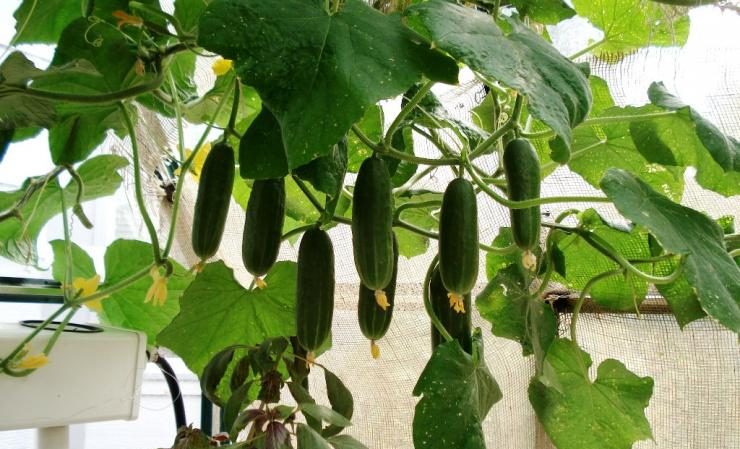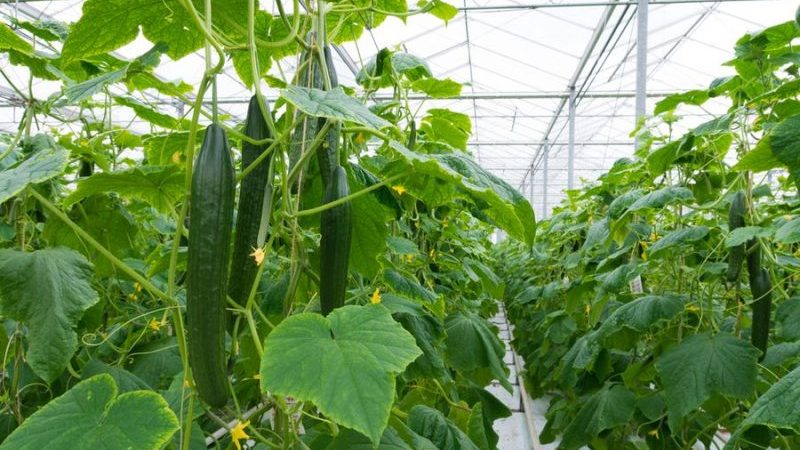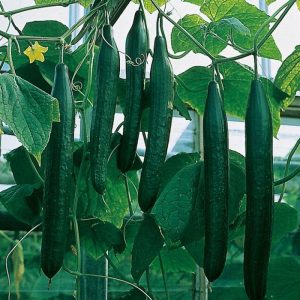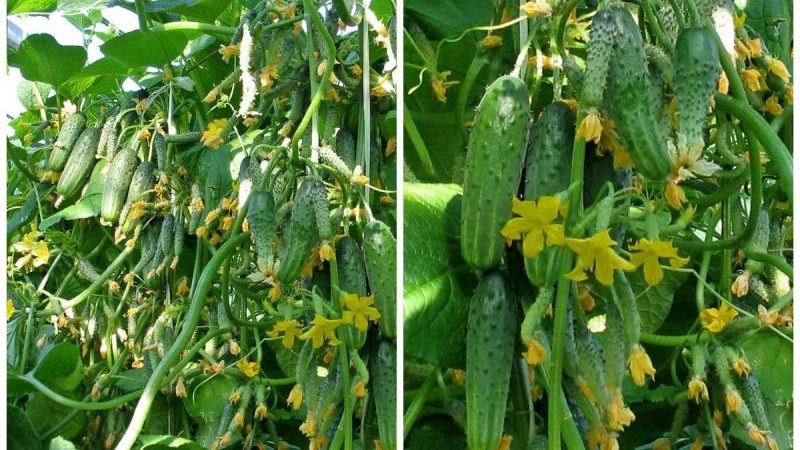The best varieties of shade-tolerant cucumbers for the greenhouse
Shade-tolerant cucumbers are suitable for growing in regions with short and cool summers. They are planted in greenhouses or hotbeds. Such varieties and hybrids do not need a lot of light, bear fruit and show excellent yields with a lack of sun. In taste and marketability, they are no worse than light-loving vegetables.
Consider varieties and hybrids of shade-tolerant cucumbers for greenhouses and learn the secrets of a rich harvest.
The content of the article
Distinctive features of shade-tolerant cucumbers
Shade-tolerant cucumbers differ from each other in purpose, ripening times, yield indicators. All these nuances must be found out before buying seeds.

What you need to know about them
Such cucumbers are early ripening, mid-ripening and late-ripening. The growing period is chosen based on climatic conditions. For the Urals and Siberia, early-ripening vegetables are suitable, for areas with a warm climate - mid-season or late.
Many shade-tolerant cucumbers are suitable for home growing. The crop ripens on a windowsill, balcony or loggia. The manufacturer indicates this information on the packaging.
The best shade-tolerant cucumbers for greenhouses
We will describe in detail the most popular shade-loving cucumbers for greenhouses and find out their advantages and disadvantages.
Dynamite f1
The bushes are indeterminate, that is, they are not limited in growth. Leaves are smooth, light green. The hybrid is grown in greenhouses and at home. Dynamite is unpretentious in leaving. The weight of the cucumber varies from 100 to 150 g, the pulp is juicy and sweet.
The yield is high - from 1 sq. m harvest about 15 kg of crispy cucumbers. In application, the hybrid is universal, suitable for fresh consumption and the preparation of salads, side dishes and winter preparations.
Mastak f1
The hybrid is intended for growing in unpredictable climatic conditions. Cold-resistant, tolerates heat and high humidity. The plant is semi-spreading, leafiness is average. The length of the vegetable is 12 cm, the shape is oval, oblong. On the surface there are pronounced tubercles. The pulp is light green, the taste is sweet, without bitterness. Mastak ripens in 60 days from the moment the first shoots appear.
reference... To obtain a rich harvest, the hybrid is planted in seedlings. Seedlings are prepared a month before planting in the greenhouse. For this, soil is poured into the container and seeds are placed. Water the seedlings once every 5 days. After 2 weeks from the moment of planting, fertilize with ammonium nitrate or liquid manure.
Green wave f1
The green wave is suitable for growing in all climates. In care, the hybrid is unpretentious, resistant to basic cultural diseases- tobacco mosaic and root rot. The fruits are lumpy, bright green in color. The flesh is tender and crispy, the rind is firm.
The crop is transported over long distances and grown for sale. Cucumbers are used for pickles and canning- prepare snacks and salads.

F1 firm secret
Shade-tolerant cucumbers take root in fertile and loose soils. The fruits are tied gradually, the return is friendly. Cucumbers have a cylindrical shape, the weight of a vegetable varies from 100 to 130 g. The structure is dense, the pulp is tasty.
The company's secret is resistant to pests, ripens in late July - early August. The delicate taste of the fruit is harmoniously combined with meat, fish and vegetable dishes.
Moscow evenings f1
Designed for growing not only in greenhouses, but also in open beds. Cold-resistant, unpretentious in care. Ripening period - from 40 to 50 days. The cucumbers are dense, slightly rounded, weighing from 90 to 120 g. The fruiting period is extended. From 1 sq. m summer residents collect about 14 kg of the crop. Excellent taste, keeping quality is long-lasting.
Interesting! 100 g of cucumber contains 15 kcal. 90% of the vegetable consists of water, which means it belongs to dietary products. Cucumber removes toxins from the body, cleanses the kidneys. Dietary fiber cleanses the intestines, has a positive effect on the thyroid gland.
Relay f1
The hybrid ripens in 50-57 days from the moment of planting. The plant is medium-branched, the leaves are large, green. The fruit is shaped like skittles - elongated and narrow. The color is even, dark green.
The lumpy peel is dense, protects the fruit from cracking and spoilage. The mass of the cucumber is 180-200 g, the thorns are white, the pulp is fragrant and sweet. The relay has an excellent yield - from 1 sq. m gardeners collect from 30 to 40 kg of beautiful cucumbers.
April f1
The April hybrid bears fruit in 40-50 days after planting. Bushes are compact, leaves are small. Fruits are cylindrical, weighing from 200 to 500 g. Length - 15–20 cm, lumpy surface. Due to their large size, cucumbers quickly deteriorate, so it is not recommended to use them for a long storage... When pickling, the fruits are cut into several pieces.
Emelya f1
Vigorous bushes are not limited in growth, so the plant needs a garter and shaping. Emelya ripens in 38–42 days. They are planted in a greenhouse with seeds or seedlings. The hybrid is resistant to diseases and insects. Vegetable weight - about 130 g, length - 15 cm, diameter - 4 cm.
The pulp is crispy and juicy, suitable for various dishes. Glossy and even fruits look attractive when sliced.
Emerald city f1
The early ripening Emerald City ripens in 35 days. The hybrid shows the best yield on light and fertile soils, therefore, before planting, organic fertilizers... Oval shape, weight - 100 g, length - 12 cm. Crispy and sweet cucumbers are suitable for whole-fruit pickling and making salads.
Important! Before planting, greenhouses are cleaned and wiped with a solution of potassium permanganate. Walls, doors and vents are disinfected to avoid diseases and pests in the future.
Garland f1
A medium-sized hybrid is grown in greenhouses and indoor conditions. The garland does not need to be pinned, it does not require special skills to care. Cucumber length - 12 cm, weight - 80–100 g. Surface with stripes and tubercles. The taste is sweet, with delicate refreshing notes.
In application, the hybrid Garland is universal, has good keeping quality.
How to choose
In addition to the timing of ripening and yield, when choosing, they pay attention to the criteria of pollination. Distinguish between self-pollinated and bee-pollinated plants.
Self-pollinated
 Such varieties and hybrids contain a pistil and stamens in one flower. The pollination process takes place independently, without the interference of insects. This is convenient in a greenhouse, you do not need to manually pollinate the cucumbers.
Such varieties and hybrids contain a pistil and stamens in one flower. The pollination process takes place independently, without the interference of insects. This is convenient in a greenhouse, you do not need to manually pollinate the cucumbers.
It is recommended to pay attention to the following hybrids:
- April f1;
- Dynamite f1;
- Moscow evenings f1;
- Garland f1;
- Mastak f1.
Bee-pollinated
Cucumbers are tied after insects have pollinated the plant. Such fruits have a pleasant aroma and sweet taste. Bee-pollinated cucumbers are grown in the shade in all regions of the country. Pollinating insects are bees or bumblebees.
Most Popular:
- Loyal friends f1;
- Hector f1;
- Children on the f1 branch;
- Kumanek f1;
- Brownie f1.
Beam

In such cucumbers, the ovaries are arranged in bunches. Bunch plants are bee-pollinated and self-pollinated. Thanks to the bundles, the yield increases several times. The stem of the bushes reaches 2 m, the fruits are compact.
The best bunch cucumbers:
- Beam splendor f1;
- F1 prestige;
- Ginga f1;
- Alligator f1;
- Okhotny Ryad f1.
What shade-tolerant cucumbers are suitable for open field
Early maturing and cold-resistant plants are planted in open ground. It is recommended to use seedlings to make it easier for the seedlings to adapt to weather conditions. After planting, the beds are covered with foil or glass for 1 week to protect them from frost and winds. 
Outdoor hybrids:
- Petersburg express f1... An early ripe hybrid yields a harvest 38–40 days after planting. A bunchy plant needs the formation and pinching of the top. The fruits are dark green, oval, with tubercles on the surface. The taste is soft and sweet. The vegetables are suitable for barrel pickling and pickling.
- Blizzard f1. Miniature bushes, short lateral shoots. They do not take much time to leave. One bush ripens from 10 to 20 cucumbers 9 cm long and weighing 80 g. Application is universal.
- Eskimo f1. The hybrid is famous for its original shape - spherical cucumbers with large pimples and thorns reach 8–10 cm in length. Taste without bitterness, pulp without water. Cucumbers appear 40–45 days after sowing the seeds.
Conclusion
Shade-tolerant cucumbers are a godsend for gardeners from regions with a cold climate. Cucumbers are cold-resistant, tolerate shade and prolonged absence of sunlight without consequences.
Self-pollinated crops are suitable for growing in a greenhouse. They have a pistil and a stamen in one flower, so there is no need to manually pollinate plants or attract insects. By taste and purpose, shade-tolerant ones are not inferior to other cucumbers, they differ in aroma and crunch.